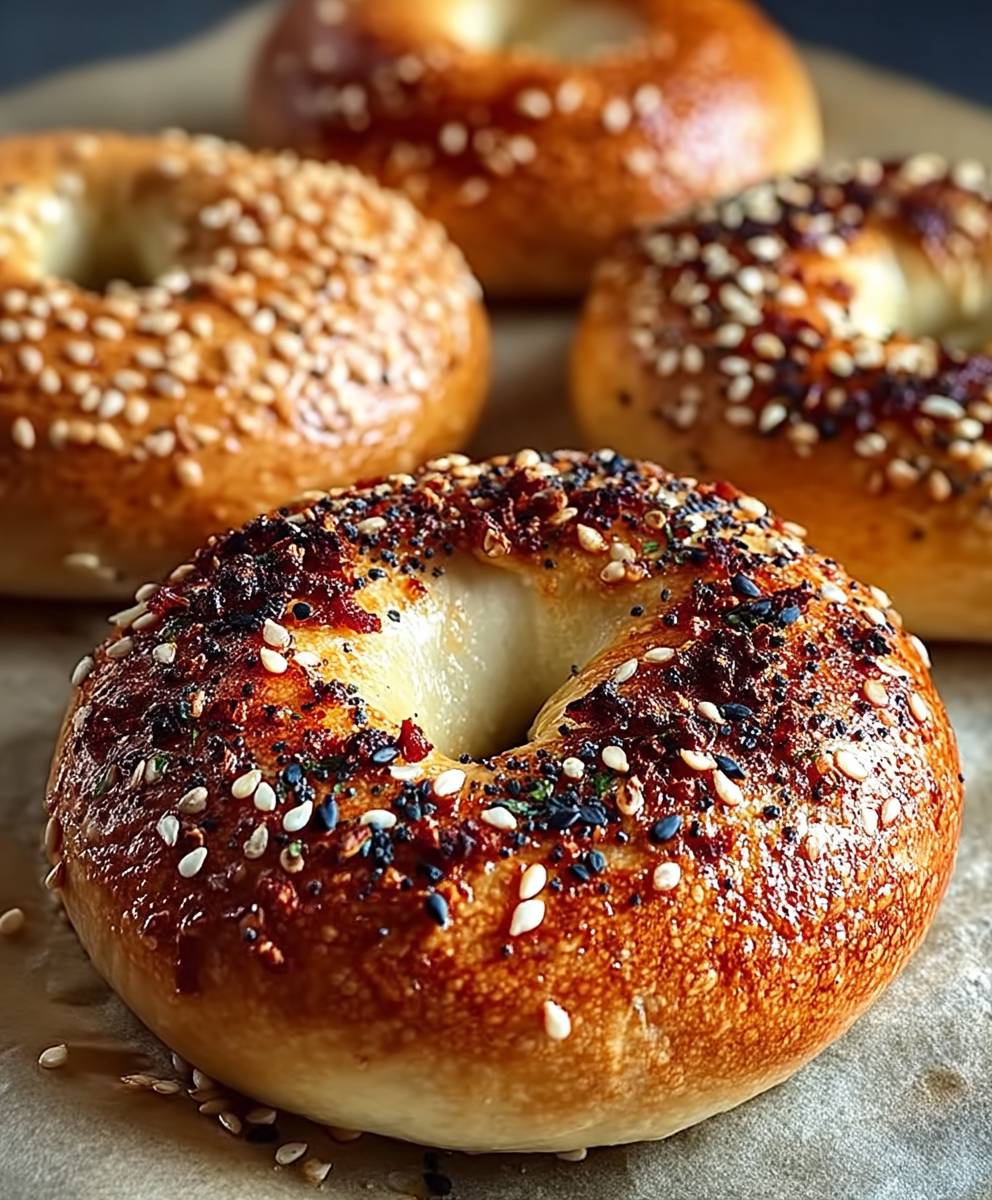Sourdough Bagels Homemade the very words conjure up images of chewy, tangy perfection, don’t they? Forget the store-bought imitations; we’re diving headfirst into the rewarding world of crafting these breakfast (or anytime!) staples from scratch. Imagine the aroma of freshly baked bagels wafting through your kitchen, a symphony of yeasty goodness that promises a delightful experience.
While the exact origins of the bagel are debated, most historians trace its roots back to Jewish communities in Poland in the 17th century. Originally called “beygl,” they were often given as gifts to women after childbirth, symbolizing good luck and a long life. Over time, bagels migrated across the Atlantic, becoming a beloved part of North American cuisine, particularly in New York City, where they underwent further refinement.
But what is it about bagels that makes them so irresistible? It’s the unique combination of a crisp, golden-brown exterior and a delightfully chewy interior. The slight tang from the sourdough starter adds another layer of complexity, elevating these bagels far beyond the ordinary. And let’s be honest, who can resist the satisfying ritual of slicing open a warm bagel and slathering it with cream cheese, lox, or your favorite toppings? Plus, making sourdough bagels homemade is surprisingly achievable, even for beginner bakers. So, let’s get started and unlock the secrets to baking the perfect sourdough bagel in your own kitchen!
Ingredients:
- For the Sourdough Starter (Levain):
- 1/4 cup (30g) active sourdough starter
- 1/2 cup (60g) bread flour
- 1/4 cup (60g) water, lukewarm
- For the Dough:
- All of the levain (sourdough starter)
- 3 1/2 cups (420g) bread flour, plus more for dusting
- 1 1/2 cups (360g) warm water (about 90-100°F)
- 2 teaspoons (12g) salt
- 1 tablespoon (15g) barley malt syrup (or honey or brown sugar)
- For the Boiling Water Bath:
- 8 cups water
- 2 tablespoons barley malt syrup (or honey or brown sugar)
- For Toppings (Optional):
- Everything bagel seasoning
- Sesame seeds
- Poppy seeds
- Dried onion flakes
- Coarse sea salt
Preparing the Levain (Sourdough Starter)
Okay, let’s get started! The first thing we need to do is prepare our levain. This is essentially feeding your sourdough starter so it’s nice and active for baking. This step is crucial for getting that signature sourdough flavor and rise in our bagels.
- Combine Ingredients: In a clean jar or bowl, combine the 1/4 cup of active sourdough starter, 1/2 cup of bread flour, and 1/4 cup of lukewarm water.
- Mix Well: Stir everything together until you have a smooth, thick batter. Make sure there are no dry clumps of flour.
- Let it Rise: Cover the jar loosely with a lid or plastic wrap. Let it sit at room temperature (ideally around 70-75°F) for about 4-6 hours, or until it has doubled in size and is bubbly and active. You’ll know it’s ready when it passes the float test a small spoonful should float in a glass of water.
Making the Bagel Dough
Now that our levain is ready, we can move on to making the bagel dough. This is where the magic really happens! Don’t be intimidated; it’s a straightforward process, and the results are so worth it.
- Combine Levain and Water: In a large bowl (or the bowl of your stand mixer), combine the entire amount of levain with the 1 1/2 cups of warm water. Stir until the levain is mostly dissolved.
- Add Flour and Salt: Add the 3 1/2 cups of bread flour and the 2 teaspoons of salt to the bowl.
- Mix the Dough: If using a stand mixer, use the dough hook attachment and mix on low speed for about 8-10 minutes, or until the dough comes together into a shaggy mass. If mixing by hand, use a wooden spoon or your hands to combine the ingredients until a shaggy dough forms.
- Knead the Dough:
- Stand Mixer: Increase the mixer speed to medium and knead for another 5-7 minutes, or until the dough is smooth, elastic, and slightly tacky. It should pull away from the sides of the bowl.
- By Hand: Turn the dough out onto a lightly floured surface and knead for 10-12 minutes, or until it’s smooth, elastic, and slightly tacky. Use a bench scraper to help you gather the dough as needed.
- Add Barley Malt Syrup: Add the 1 tablespoon of barley malt syrup (or honey or brown sugar) to the dough and knead for another minute or two until it’s fully incorporated. This adds a touch of sweetness and helps with browning.
- First Rise (Bulk Fermentation): Place the dough in a lightly oiled bowl, turning to coat. Cover the bowl with plastic wrap or a damp towel. Let the dough rise in a warm place for 2-3 hours, or until it has almost doubled in size. This is called bulk fermentation, and it’s essential for developing the flavor of the sourdough.
Shaping the Bagels
Time to shape those bagels! This is a fun part, and there are a couple of ways to do it. I’ll show you my preferred method, but feel free to experiment and find what works best for you.
- Divide the Dough: Gently punch down the dough to release the air. Turn it out onto a lightly floured surface. Divide the dough into 8 equal pieces (about 120-130g each).
- Shape into Balls: Gently shape each piece of dough into a smooth, round ball.
- Rest the Balls: Cover the dough balls with a damp towel and let them rest for 15-20 minutes. This allows the gluten to relax, making them easier to shape.
- Shape the Bagels (Method 1 – Poke a Hole):
- Take one dough ball and flatten it slightly with your hand.
- Use your thumb to poke a hole through the center of the dough.
- Gently stretch and widen the hole, rotating the dough as you go, until you have a bagel shape with a hole that’s about 1-1.5 inches in diameter.
- Shape the Bagels (Method 2 – Rope Method):
- Roll each dough ball into a rope about 8-10 inches long.
- Wrap the rope around your hand, overlapping the ends.
- Pinch the ends together firmly to seal the bagel shape.
- Second Rise (Proofing): Place the shaped bagels on a baking sheet lined with parchment paper. Cover them loosely with plastic wrap or a damp towel. Let them proof in the refrigerator for at least 12 hours, or up to 24 hours. This slow, cold proofing develops even more flavor and gives the bagels a chewy texture.
Boiling and Baking the Bagels
Almost there! The boiling step is what gives bagels their characteristic chewy crust. Don’t skip it!
- Preheat Oven: Preheat your oven to 450°F (232°C). Place a rack in the center of the oven.
- Prepare Boiling Water: In a large pot, bring 8 cups of water and 2 tablespoons of barley malt syrup (or honey or brown sugar) to a rolling boil.
- Boil the Bagels: Gently drop 2-3 bagels into the boiling water at a time. Boil for 1-2 minutes per side. The longer you boil them, the chewier they will be.
- Remove and Drain: Use a slotted spoon or spatula to carefully remove the bagels from the boiling water. Place them back on the parchment-lined baking sheet.
- Add Toppings (Optional): While the bagels are still wet, sprinkle them with your desired toppings, such as everything bagel seasoning, sesame seeds, poppy seeds, dried onion flakes, or coarse sea salt. Gently press the toppings into the dough to help them adhere.
- Bake the Bagels: Bake the bagels for 20-25 minutes, or until they are golden brown and sound hollow when tapped on the bottom.
- Cool and Enjoy: Transfer the baked bagels to a wire rack to cool completely before slicing and enjoying.
Tips for Success
- Use Bread Flour: Bread flour has a higher protein content than all-purpose flour, which is essential for developing the gluten structure needed for chewy bagels.
- Don’t Overproof: Overproofed bagels will collapse during baking. The cold proofing in the refrigerator helps to prevent this.
- Adjust Boiling Time: Adjust the boiling time to your preference. Longer boiling times will result in chewier bagels.
- Get Creative with Toppings: Experiment with different toppings to create your own signature bagel flavors.
- Storage: Store leftover bagels in an airtight container at room temperature for up to 2 days, or in the freezer for longer storage. To reheat frozen bagels, thaw them completely and then toast or bake them until warmed through.

Conclusion:
So, there you have it! My take on homemade sourdough bagels. I truly believe this recipe is a must-try for any baking enthusiast, whether you’re a seasoned sourdough pro or just starting your journey. The slightly tangy flavor, the chewy interior, and the perfectly crisp crust it’s a symphony of textures and tastes that will have you hooked from the very first bite. Forget store-bought bagels; once you experience the satisfaction of creating these beauties from scratch, you’ll never look back!
What makes these bagels so special? It’s the combination of the slow fermentation process, which develops incredible depth of flavor, and the traditional boiling method, which gives them that signature chewy texture. Plus, the active sourdough starter adds a unique complexity that you just can’t replicate with commercial yeast. It’s a labor of love, yes, but the reward is well worth the effort. Trust me on this one!
Serving Suggestions and Variations:
Now, let’s talk about how to enjoy these magnificent creations. The possibilities are endless! Of course, the classic cream cheese is always a winner. But don’t stop there! Try topping them with smoked salmon and dill, avocado and everything bagel seasoning, or even a fried egg and bacon for a truly decadent breakfast. For a sweeter treat, spread on some Nutella or peanut butter and banana slices.
And if you’re feeling adventurous, why not experiment with different variations? Add some blueberries or cranberries to the dough for a fruity twist. Incorporate some shredded cheese and jalapeños for a savory kick. Or try using different types of flour, like whole wheat or rye, to add a nutty flavor. You can even play around with the toppings poppy seeds, sesame seeds, dried onion flakes, or even a sprinkle of sea salt. The only limit is your imagination!
I personally love to slice my sourdough bagels in half, toast them until golden brown, and then slather them with a generous layer of homemade garlic herb cream cheese. It’s the perfect combination of savory, tangy, and garlicky goodness. But honestly, they’re delicious any way you choose to enjoy them.
Don’t be intimidated by the thought of making your own bagels. This recipe is surprisingly straightforward, and I’ve included plenty of tips and tricks to help you succeed. Just follow the instructions carefully, be patient with the dough, and most importantly, have fun! Baking should be a joyful experience, so relax, put on some music, and enjoy the process.
I’m so excited for you to try this recipe and experience the magic of homemade sourdough bagels for yourself. Once you do, I’d love to hear about your experience! Share your photos and stories on social media using [Your Hashtag Here], and let me know what variations you tried and how they turned out. I’m always looking for new ideas and inspiration, and I can’t wait to see what you create. Happy baking!
So go ahead, preheat your oven, gather your ingredients, and get ready to embark on a delicious baking adventure. You won’t regret it!
Sourdough Bagels Homemade: The Ultimate Guide to Baking at Home
Homemade sourdough bagels with a chewy crust and delicious tangy flavor. Boil and bake for the perfect texture.
Ingredients
- 1/4 cup (30g) active sourdough starter
- 1/2 cup (60g) bread flour
- 1/4 cup (60g) water, lukewarm
- All of the levain (sourdough starter)
- 3 1/2 cups (420g) bread flour, plus more for dusting
- 1 1/2 cups (360g) warm water (about 90-100°F)
- 2 teaspoons (12g) salt
- 1 tablespoon (15g) barley malt syrup (or honey or brown sugar)
- 8 cups water
- 2 tablespoons barley malt syrup (or honey or brown sugar)
- Everything bagel seasoning
- Sesame seeds
- Poppy seeds
- Dried onion flakes
- Coarse sea salt
Instructions
- Preparing the Levain (Sourdough Starter): In a clean jar or bowl, combine the 1/4 cup of active sourdough starter, 1/2 cup of bread flour, and 1/4 cup of lukewarm water. Stir until smooth. Cover loosely and let sit at room temperature (70-75°F) for 4-6 hours, or until doubled and bubbly. It should pass the float test.
- Making the Bagel Dough: In a large bowl (or stand mixer bowl), combine the levain with 1 1/2 cups of warm water. Stir until mostly dissolved. Add 3 1/2 cups of bread flour and 2 teaspoons of salt.
- Mix the Dough:
- Stand Mixer: Use the dough hook on low speed for 8-10 minutes, until a shaggy mass forms.
- By Hand: Combine ingredients until a shaggy dough forms.
- Knead the Dough:
- Stand Mixer: Increase speed to medium and knead for 5-7 minutes, until smooth, elastic, and slightly tacky.
- By Hand: Turn out onto a lightly floured surface and knead for 10-12 minutes, until smooth, elastic, and slightly tacky.
- Add 1 tablespoon of barley malt syrup (or honey or brown sugar) and knead for 1-2 minutes until incorporated.
- First Rise (Bulk Fermentation): Place dough in a lightly oiled bowl, turning to coat. Cover and let rise in a warm place for 2-3 hours, or until almost doubled.
- Shaping the Bagels: Gently punch down the dough. Turn out onto a lightly floured surface. Divide into 8 equal pieces (120-130g each).
- Shape each piece into a smooth ball. Cover and let rest for 15-20 minutes.
- Shape the Bagels (Method 1 – Poke a Hole): Flatten a dough ball slightly. Poke a hole through the center. Stretch and widen the hole to 1-1.5 inches in diameter.
- Shape the Bagels (Method 2 – Rope Method): Roll each dough ball into an 8-10 inch rope. Wrap around your hand, overlapping the ends. Pinch the ends together firmly to seal.
- Second Rise (Proofing): Place shaped bagels on a parchment-lined baking sheet. Cover loosely and proof in the refrigerator for 12-24 hours.
- Boiling and Baking the Bagels: Preheat oven to 450°F (232°C). Place a rack in the center of the oven.
- In a large pot, bring 8 cups of water and 2 tablespoons of barley malt syrup (or honey or brown sugar) to a rolling boil.
- Gently drop 2-3 bagels into the boiling water. Boil for 1-2 minutes per side.
- Remove with a slotted spoon and place back on the baking sheet.
- Add toppings (optional) while the bagels are still wet. Gently press them into the dough.
- Bake for 20-25 minutes, or until golden brown and sound hollow when tapped.
- Cool completely on a wire rack before slicing and enjoying.
Notes
- Use bread flour for best results.
- Don’t overproof the bagels.
- Adjust boiling time for desired chewiness.
- Experiment with different toppings.
- Store leftover bagels in an airtight container at room temperature for up to 2 days, or freeze for longer storage. Reheat frozen bagels by thawing and toasting or baking.





Leave a Comment